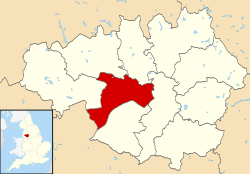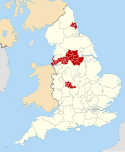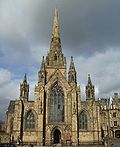City of Salford
Salford (/ˈsɒlfərd/ SOL-fərd),[5] also known as the City of Salford, is a metropolitan borough with city status in Greater Manchester, England. The borough is named after its main settlement, Salford, but covers a larger area which includes the towns of Eccles, Swinton, Walkden and Pendlebury.[6] The borough had a population of 278,064 in 2022,[3] and is administered from the Salford Civic Centre in Swinton.
Salford is the historic centre of the Salford Hundred an ancient subdivision of Lancashire. The City of Salford is the fifth-most populous district in Greater Manchester.[3] The city's boundaries, set by the Local Government Act 1972, include five former local government districts. It is bounded on the southeast by the River Irwell, which forms part of its boundary with Manchester to the east, and by the Manchester Ship Canal to the south, which forms its boundary with Trafford. The metropolitan boroughs of Wigan, Bolton, and Bury lie to the west, northwest, and north respectively. Some parts of the city, which lies directly west of Manchester, are highly industrialised and densely populated, but around one-third of the city consists of rural open space. The western half of the city stretches across an ancient peat bog, Chat Moss.
Salford has a history of human activity stretching back to the Mesolithic age. There are over 250 listed buildings in the city, including Salford Cathedral, and three Scheduled Ancient Monuments. With the Industrial Revolution, Salford and its neighboring settlements grew alongside the textile industry. The former County Borough of Salford was granted city status in 1926 and thus making it the second city in Greater Manchester after neighbouring Manchester. The city and its industries experienced a decline throughout much of the 20th century. Since the 1990s, parts of Salford have undergone regeneration, especially Salford Quays, home of BBC North and Granada Television, and the area around the University of Salford.
Salford Red Devils are a professional rugby league club in Super League and Salford City F.C. is a professional football club in League Two.
History
[edit]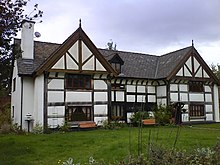

Although the metropolitan borough of the City of Salford was a 20th-century creation, the area has a long history of human activity, extending back to the Stone Age. Neolithic flint arrow-heads and tools, and evidence of Bronze Age activity has been discovered in Salford.[7] The northerly section of Watling Street, a Roman road from Manchester (Mamucium) via Bury to Ribchester (Bremetennacum), passes through the city;[8] a hoard of over 550 bronze Roman coins dating between 259 AD and 278 AD was discovered in Boothstown;[9] and a Romano-British bog body, Worsley Man, was discovered in the Chat Moss peat bog.[10]
In 1142, a monastic cell (small monastic house) dedicated to St. Leonard was established in Kersal.[8] The 12th century hundred of Salford was created as Salfordshire in the historic county of Lancashire and survived until the 19th century,[11] when it was replaced by one of the first county boroughs in the country. Salford became a free borough in about 1230,[12] when it was granted a charter as a free borough by the Earl Ranulph of Chester.[13] The cell in Kersal was sold in 1540 during the Dissolution of the Monasteries.[8] A 16th-century manor house, called Kersal Cell, was built on the site of the priory.[14] In the English Civil War between King Charles I and parliament, Salford was Royalist.[15] Salford was also noted as Jacobite territory; its inhabitants supported Charles Edward Stuart's claim to the Kingdom of Great Britain and hosted him when he rode through the area during the Jacobite rising of 1745.[15]
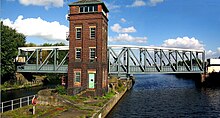
During the Industrial Revolution, Salford grew as a result of the textile industry.[16] Although Salford experienced an increase in population, it was overshadowed by the dominance of Manchester and did not evolve as a commercial centre in the same way.[17] On 15 September 1830, Eccles was site of the world's first railway accident.[18] During a stop in Eccles to take on water, William Huskisson, Member of Parliament for Liverpool, had his leg crushed by Stephenson's Rocket; at the time he was in conversation with the Duke of Wellington, who was opening the railway, and did not get out of the way of the train in time. Although Huskisson was taken to Eccles for treatment he died of his injuries.[19] The six-foot-tall Oglala Sioux tribesman, "Surrounded By the Enemy", died here from a bronchial infection at age twenty-two in 1887 during a tour of Buffalo Bill's Wild West Show and was buried at Brompton Cemetery.[20] In 1894, the Manchester Ship Canal was opened, running from the River Mersey to Salford Quays; when it was complete it was the largest navigation canal in the world.[21] Along the route of the canal, it was necessary to create an aqueduct carrying the Bridgewater Canal over the Ship Canal. The Barton Swing Aqueduct, designed by Sir Edward Leader Williams,[22] is 100 metres (330 ft) long and weighs 1,450 metric tons (1,427 long tons; 1,598 short tons).[23][24]
At the start of the 20th century, Salford began to decline due to competition from outside the UK. A survey in 1931 concluded that parts of Salford were amongst the worst slums in the country.[25] Salford was granted city status in 1926.[26] During World War II, Salford Docks were regularly bombed.[27]
In the decades following the Second World War there was a significant economic and population decline in Salford.[28] In 1961 a small part of Eccles was added to the city. On 1 April 1974, the City and County Borough of Salford was abolished under the Local Government Act 1972, and was replaced by the metropolitan borough of City of Salford, one of ten local government districts in the new metropolitan county of Greater Manchester.[11][29] The city status of the new district was confirmed by additional letters patent issued on the same day.[30] Since the early 1990s, the decline has slowed.[28]
Prior to the metropolitan borough's creation, the name Salford for the new local government district courted controversy. Salford was "thought second-class by those in Eccles", who preferred the new name "Irwell" for the district (with reference to the River Irwell).[31] A councillor for the then City and County Borough of Salford objected to this suggestion, stating this label was nothing but "a dirty stinking river".[31] The name Irwell won 8 votes to Salford's 7, but a private protest and deliberation favoured Salford as the name for the new city, citing that the River Irwell would pass through two other Greater Manchester districts, and that it "doesn't touch Worsley".[31]
Geography
[edit]
The City of Salford is bounded to the north by the Metropolitan Borough of Bolton and Metropolitan Borough of Bury. To the south by the Metropolitan Borough of Trafford and to the west by the Metropolitan Borough of Wigan. Manchester lies directly across the river from Salford. The natural mossland of Chat Moss lies in the south western corner of the city; it covers an area of about 10.6 square miles (27.5 km2), accounting for about 30% of the city's area,[32] and lies 75 feet (23 m) above sea level.[33] The moss makes up the largest area of prime farmland in Greater Manchester.[32] Kersal Moor is an area of moorland spanning 8 hectares (20 acres) in Kersal; it is a local nature reserve and a Site of Biological Importance.[34][35] Greenspace accounts for 55.7% of the City of Salford's total area, domestic buildings and gardens comprise 20.0%, and the rest is made up of roads and non-domestic buildings.[36]
To the south of Salford are the docks of Salford Quays, now home to the MediaCityUK. MediaCityUK is a large area that crosses the boundary into Trafford Park, Trafford. Although Salford Quays is in the City of Salford and has created job opportunities and more housing since the 2010s when it was built.
The River Irwell runs south east through Kearsley, Clifton and Agecroft then meanders around Lower Broughton and Kersal, Salford Crescent and the centre of Manchester, joining the rivers Irk and Medlock. Turning west, it meets the Mersey south of Irlam, where the route of the river was altered in the late 19th century to form part of the course of the Manchester Ship Canal. The ship canal, opened in 1894, forms part of Salford's southern boundaries with Trafford.[37] The city's climate is generally temperate, like the rest of Greater Manchester. The nearest weather station is 10 miles (16 km) away at Ringway, in Manchester; the mean highest and lowest temperatures (13.2 °C (55.8 °F) and 6.4 °C (43.5 °F)) are slightly above the national average, while the annual rainfall (806.6 millimetres (31.76 in)) and average hours of sunshine (1394.5 hours) are respectively above and below the national averages.[38][39]
Governance
[edit]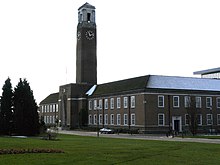
Parliamentary constituencies
[edit]The City of Salford is represented by Members of Parliament (MPs) for three constituencies, Salford by Rebecca Long-Bailey (Labour),[40] Worsley and Eccles by Michael Wheeler (Labour),[41] and Blackley and Middleton South by Graham Stringer (Labour).[42]
Council
[edit]In 1974, Salford City Council was created to administer the newly formed local government district. Until 1986, it shared power with the Greater Manchester County Council. The council offices are in Swinton, in what was formerly Swinton and Pendlebury Town Hall. The Labour Party have been in control of the council since its formation in 1974.[43] The council has a constitution detailing how they should operate in performing their duties.[44]
Salford City Council was assessed by the Audit Commission and judged to be "improving well" in providing services for local people. Overall the council was awarded "three star" status meaning it was "performing well" and "consistently above minimum requirements", similar to 46% of all local authorities.[45]
The metropolitan borough of the City of Salford is based on the former County Borough of the City of Salford which included the city centre, Pendleton, Weaste, Claremont, Langworthy, Broughton, Kersal, Ordsall and Seedley. The city is entirely unparished and absorbed the municipal boroughs of Eccles and Swinton and Pendlebury and the urban districts of Irlam and Worsley. An urban district was a type of local government district which covered an urbanised area.
Since 2012, in addition to the long-existing and largely ceremonial, annually appointed civic mayor of Salford, the city has also had a directly elected mayor.
| Party | Seats in 2024 | |
|---|---|---|
| Labour | 50 | |
| Conservative | 7 | |
| Lib Dems | 2 | |
| Independent | 1 | |
Electoral wards
[edit]There are 60 councillors representing 20 wards. Swinton and Walkden have six councillors each.[46]
| Ward name | Area (ha)/mi2 | Population (2014) |
|---|---|---|
| Barton | 244 hectares (0.94 sq mi)[47] | 12,462 [48] |
| Boothstown and Ellenbrook | 860 hectares (3.3 sq mi)[49] | 9,532 [50] |
| Broughton | 267 hectares (1.03 sq mi)[51] | 14,916 [52] |
| Cadishead | 1,476 hectares (5.70 sq mi)[53] | 10,739 [54] |
| Claremont | 190 hectares (0.73 sq mi)[55] | 10,166 [56] |
| Eccles | 270 hectares (1.0 sq mi)[57] | 11,499 [58] |
| Irlam | 935 hectares (3.61 sq mi)[59] | 9,857 [60] |
| Irwell Riverside | 451 hectares (1.74 sq mi)[61] | 12,939 [62] |
| Kersal | 313 hectares (1.21 sq mi)[63] | 12,929 [64] |
| Langworthy | 203 hectares (0.78 sq mi)[65] | 12,980 [66] |
| Little Hulton | 452 hectares (1.75 sq mi)[67] | 13,469 [68] |
| Ordsall | 414 hectares (1.60 sq mi)[69] | 16,725 [70] |
| Pendlebury | 662 hectares (2.56 sq mi)[71] | 13,434 [72] |
| Swinton North | 349 hectares (1.35 sq mi)[73] | 11,473 [74] |
| Swinton South | 281 hectares (1.08 sq mi)[75] | 11,458 [76] |
| Walkden North | 448 hectares (1.73 sq mi)[77] | 12,232 [78] |
| Walkden South | 361 hectares (1.39 sq mi)[79] | 10,185 [80] |
| Weaste and Seedley | 354 hectares (1.37 sq mi)[81] | 12,616 [82] |
| Winton | 370 hectares (1.4 sq mi)[83] | 12,339 [84] |
| Worsley | 838 hectares (3.24 sq mi)[85] | 10,090 [86] |
Central Salford and Salford West
[edit]The district is divided into two areas (Central Salford and Salford West)[87] for some purposes including planning, regeneration and housing.
- Central Salford is the eastern part of the district and comprises seven wards: Broughton, Claremont, Irwell Riverside, Kersal, Ordsall, Langworthy and Weaste & Seedley. This is the more urban half of the district and lies partly within the Manchester Inner Ring Road. Salford Quays lies within this area. Between 2005 and 2011, the Central Salford Urban Regeneration Company was responsible for urban regeneration in this area, securing over £1 billion of private sector investment.[88] Social housing is provided by Salix Homes in this area.
- Salford West comprises the other 13 wards, including the towns of Eccles, Pendlebury, Swinton and Walkden. This is the more suburban and rural half of the district. Salford City Council's aspiration is that "In 2028, Salford West will be one of the most desirable and prosperous areas in Greater Manchester."[89] Social housing is provided by City West Housing Trust in this area.
Coat of arms
[edit]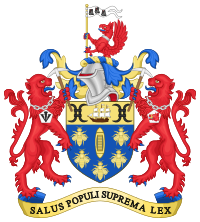
|
|
The coat of arms of Salford City Council depicts a weaving shuttle surrounded by five bees with a three masted ship above, on a shield flanked by two lions.[91] The blue background with a gold chief is taken from the arms of the city council of the County Borough of Salford, who in turn took it from the colours of the Earl of Chester. The shuttle and five bees represent the industry of the area and five settlements who benefited from the textile industry.[91] The ship is borrowed from the crest of Eccles Borough Council and represents the importance of waterways to the city. The ship is flanked by two millrinds – the iron centres of millstones – symbolising engineering.[91] The lions are taken from the crest of the Borough of Swinton and Pendlebury; they are wearing iron steel chain representing engineering. The shield is topped by a griffin carrying a pennon depicting three boars' heads. The griffin is taken from the crest of Eccles and the boars are from the crest of Irlam Urban District.[91] Beneath the shield is a scroll reading salus populi suprema lex, Latin for "the welfare of the people is the highest law".[91]
Budget
[edit]In 2017–18, Salford City Council agreed to spend £267 million. They agreed an estimated £79M on children's services (30%); £56M on community health and social care (21%); £40M on levies and charges (15%); £39M on environment and community safety (14%); £36M and on capital financing (13%); £9M on corporate business (3%); £7M on regeneration (3%); and £2M on public health, reform and commissioning (1%). For the 2016–17 financial year, the council's income is expected to consist of £65M including council tax and efficiency savings. The net expenditure is therefore expected to be £202M.[92]
Audit
[edit]A Comprehensive Area Assessment by the Audit Commission in 2009 found that Salford's key priorities are improving health, reducing crime, helping young people achieve A-level qualifications, social services, including the views of minority groups, improving skills and "making Salford a cleaner and more attractive place to live".[93]
Demography
[edit]Ethnicity
[edit]| Ethnic Group | Year | |
|---|---|---|
| 2021[94] | ||
| Number | % | |
| White: Total | 222,248 | 82.4 |
| White: British | 199,614 | 74.0 |
| White: Irish | 2,882 | 1.1 |
| White: Roma | 515 | 0.2 |
| White: Gypsy or Irish Traveller | 295 | 0.1 |
| White: Other | 18,942 | 7.0 |
| Asian or Asian British: Total | 14,938 | 5.5 |
| Asian or Asian British: Indian | 3,744 | 1.4 |
| Asian or Asian British: Pakistani | 4,074 | 1.5 |
| Asian or Asian British: Bangladeshi | 803 | 0.3 |
| Asian or Asian British: Chinese | 3,319 | 1.2 |
| Asian or Asian British: Other Asian | 2,998 | 1.1 |
| Black or Black British: Total | 16,473 | 6.1 |
| Black or Black British: African | 13,477 | 5.0 |
| Black or Black British: Caribbean | 1,338 | 0.5 |
| Other Black | 1,658 | 0.6 |
| Mixed or British Mixed: Total | 8,501 | 3.2 |
| Mixed: White and Black Caribbean | 2,596 | 1.0 |
| Mixed: White and Black African | 2,098 | 0.8 |
| Mixed: White and Asian | 1,844 | 0.7 |
| Mixed: Other Mixed | 1,963 | 0.7 |
| Other: Total | 7,762 | 2.9 |
| Other: Arab | 3,214 | 1.2 |
| Other: Any other ethnic group | 4,548 | 1.7 |
| Total | 269,923 | 100% |
At the 2011 UK census, the City of Salford had a total population of 233,933.[95] Of the 103,556 households in Salford, 25.4% were married or same-sex civil partnership couples living together, 36.4% were one-person households, 11.2% were co-habiting couples and 13.5% were lone parents. The figures for lone parent households were above the national average of 10.6%, and the percentage of married couples was also below the national average of 33.2%; the proportion of one person households was higher than the national average of 30.3%.[96]
The population density was 24.1 persons per hectare (Salford covers 9,719 hectares), 117,151 (50.1%) female, and 116,782 (49.9%) male.[97] Of those aged 16–74 in Salford, 27.1% had no academic qualifications, significantly higher than 22.5% in all of England.[98] 11.8% of Salford's residents were born outside the United Kingdom, lower than the national average of 13.8%.[99] The largest minority group was recorded as Asian, at 4.1% of the population.[100]
The number of theft from a vehicle offences and theft of a vehicle per 1,000 of the population was 21.3 and 7.9 compared to the English national average of 7.6 and 2.9 respectively.[101] The number of sexual offences was 1.1 compared to the average of 0.9.[101] The national average of violence against another person was 16.7 compared to the Salford average of 27.2.[101] The figures for crime statistics were all recorded during the 2006/7 financial year.[102] Although all were above the averages for England, Salford's crime rate was lower than Manchester's.[103]
Population change
[edit]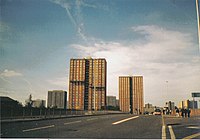
The table below details the population change since 1801, including the percentage change since the last available census data. Although the City of Salford has existed as a metropolitan borough since 1974, figures have been generated by combining data from the towns, villages, and civil parishes that would later be constituent parts of the city.
|
|
| ||||||||||||||||||||||||||||||||||||||||||||||||||||||||||||||||||||||||||||||
| Source: Vision of Britain[104] | ||||||||||||||||||||||||||||||||||||||||||||||||||||||||||||||||||||||||||||||||
Religion
[edit]
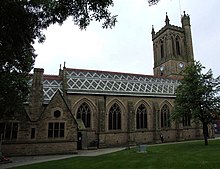
The following table shows the religious identity of residents residing in the city of Salford.
| Religion | 2011[105] | 2021[106] | ||
|---|---|---|---|---|
| Number | % | Number | % | |
| Christian | 150,111 | 64.2 | 128,785 | 47.7 |
| Muslim | 6,030 | 2.6 | 13,542 | 5.0 |
| Jewish | 7,687 | 3.3 | 10,373 | 3.8 |
| Hindu | 1,504 | 0.6 | 2,113 | 0.8 |
| Sikh | 324 | 0.1 | 728 | 0.3 |
| Buddhism | 1,040 | 0.4 | 1,022 | 0.4 |
| Other religion | 691 | 0.3 | 1,068 | 0.4 |
| No religion | 52,105 | 22.3 | 96,140 | 35.6 |
| Religion not stated | 14,441 | 6.2 | 16,152 | 6.0 |
| Total | 233,933 | 100.00% | 269,923 | 100.00% |
Salford is covered by the Roman Catholic Diocese of Salford,[107] and the Church of England Diocese of Manchester.[108]
During the mid-19th century, there was an influx of Irish people into the Salford area, largely due to the famine in Ireland.[109] In 1848, Salford Roman Catholic Cathedral was consecrated, reflecting Salford's large Irish-born community at the time.[110]
Of Salford's six Grade I listed buildings, three are churches. St Augustine's Church, Pendlebury, was built in 1874 by George Frederick Bodley.[111] The Church of St Mary the Virgin, in Eccles, was originally built in the 13th century but was expanded in the 15th. A church has been on the site since at least the 12th century.[111][112] St Mark's Church, Worsley was built in 1846 by George Gilbert Scott.[111] The six Grade II* listed churches are the Church of St Andrew in Eccles,[111][113] the Cathedral Church of St John,[114] the Church of St Luke in Pendleton,[115] Monton Unitarian Church in Monton,[116] the Church of St Philip in Salford,[117] and the United Reformed Church.[111]
Economy
[edit]
Salford Docks (also called Manchester Docks) were opened by Queen Victoria in 1894, providing docks in Manchester and Salford for the Manchester Ship Canal which linked Manchester to the sea.[118] During the 1970s, the docks fell into decline as they proved too small for new, larger ships,[118] and when they were abandoned in 1982 over 3,000 people lost their jobs.[118] Salford City Council purchased the docks in 1984 and since then they underwent regeneration as a centre of tourism in Salford, which included the construction of the Lowry Centre.[118] More than 10,000 people are employed in the Quays in jobs such as retail, construction, and e-commerce.[119] In 2007, it was confirmed that the BBC would be moving five of its departments to a new development on Pier 9 of Salford Quays, called MediaCityUK.[120] The move was completed in 2011.
| City of Salford Compared | |||
|---|---|---|---|
| 2011 UK Census[121] | City of Salford | North West | England |
| Population of working age | 173,117 | 5,184,216 | 38,881,374 |
| Full-time employment | 39.3% | 37.5% | 38.6% |
| Part-time employment | 12.5% | 13.9% | 13.7% |
| Self employed | 6.6% | 8.2% | 9.8% |
| Unemployed | 5.2% | 4.7% | 4.4% |
| Retired | 12.1% | 14.8% | 13.7% |
Finance and professional services, tourism and culture, and computer and internet based services have been identified as growth industries in Greater Manchester and are concentrated in Manchester and Salford.[122] Average house prices in the City of Salford are sixth out of all the metropolitan boroughs in Greater Manchester, 7.6% lower than the average for the county.[123] There are, however, areas of considerable affluence, within the city, such as Broughton Park, parts of Kersal, Ellesmere Park, Worsley, parts of Swinton and Pendlebury and the ultra-modern Salford Quays.
At the 2011 UK census, Salford had 173,117 residents aged 16 to 74. 4.7% of these people were students with jobs, 4.1% looking after home or family, 6.9% permanently sick or disabled and 2.9% economically inactive for other reasons. The City of Salford has a high rate of people who are permanently sick and disabled, 70% higher than the national average of 4.0%.[121]
In 2011, of 106,904 residents of the City of Salford in employment, the industry of employment was: 17.8% retail and wholesale; 7.6% manufacturing;13.7% health and social work; 8.7% education; 7.2% construction; 5.2% transport and storage; 6.6% accommodation and food service; 6.2% administrative and support services; 6.0% professional, scientific and technical; 5.1% public administration and defence; 4.4% financial and insurance; 3.4% information and communication; 1.6% real estate; 0.9% water supply and waste management; 0.6% energy supply; 0.1% agriculture, forestry and fishing; 0.1% mining and quarrying; and 4.7% other. This was roughly in line with national figures, except for the proportion of jobs in agriculture which is less than half the national average, reflecting the city's suburban nature and its proximity to the centre of Manchester.[124]
JCDecaux UK has its Manchester office in the Metroplex Business Park in Salford.[125]
Culture
[edit]Museums and arts
[edit]

Salford Museum and Art Gallery is situated in Peel Park. Opened in 1850, the institution is devoted to the history of Salford and Victorian art and architecture. The Salford collection includes works by artists such as Christian Ludwig Bokelmann, Charles Landseer and Thomas Henry Illidge, and ceramics from Pilkington's Lancastrian Pottery & Tiles.[126][127] Its extensive collection of artworks by the Salford-born painter L. S. Lowry was transferred to The Lowry in 2000. The museum also contains an indoor re-creation of a typical Victorian street, Lark Hill Place, which was built in 1957 using shop fronts that had been saved from demolition.[128]
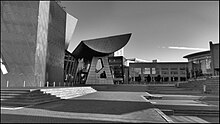

At the southern edge of Salford lies The Lowry arts centre, on the waterfront of Salford Quays. Opened in 2000, it is named after the artist and houses the city's collection of Lowry artworks. Notable paintings on display there include Going to the Match (1953) and Industrial Landscape (1953).[129] The building also contains two theatres and a drama studio, hosting drama, concerts, opera and dance events.[130]
Landmarks
[edit]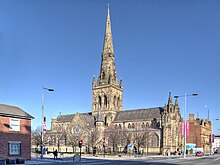
As of September 2003, the City of Salford has 6 Grade I, 14 Grade II*, and 253 Grade II listed buildings.[131] The city has the equal second highest number of Grade I listed buildings out of the districts of Greater Manchester, behind Manchester. The Grade I listed buildings are the Church of St Augustine, the Parish Church of St Mary the Virgin, St Mark's Church, Ordsall Hall, Wardley Hall, and a bridge over the River Irwell.[131] Salford Cathedral, built in 1845, is the seat of the Roman Catholic Diocese of Salford and a Grade II* listed building.[132] Most of Salford's tallest buildings are mid-20th century residential tower blocks or 21st century high rise apartments. A study by Christopher Collier of the University of Salford suggested that Manchester's drizzly climate is largely due to the multitude of high-rise blocks in Salford.[133][134] Collier has proposed that they have a "dramatic influence on the region's weather patterns", and may contribute to the 8 °C (14 °F) temperature difference between Salford and its surrounding countryside.[133]
There are three Scheduled Ancient Monuments in the city. The oldest is an Iron Age promontory fort occupied from 500 BC–200 AD.[135] Also scheduled is Hanging Bridge on the border with Manchester, dating to the 14th century,[136] and an underground section of the Bridgewater Canal in Swinton built in 1759.[137]
Sport
[edit]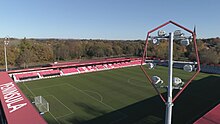
Salford is home to a number of past and present rugby league teams. Founded in 1873, Salford Red Devils play in the Super League at the AJ Bell Stadium, in Barton, Salford.[138] They are 6 times Champions and they won the Challenge Cup in 1938,[139] and have experienced two previous stretches in the Super League, 1997–2002 and 2004–2007.[140][141] In 2008 they won the Northern Rail Cup beating Doncaster 60–0 in the Final at Blackpool. They previously won the same trophy in 2003. They also won the National League 1 Grand Final in 2008, beating Celtic Crusaders after extra time in Warrington.[142] Construction on a new 20,000 seat £35 million pound stadium was complete in 2012. Now named the AJ Bell stadium it is home to Salford Red Devils and Sale Sharks rugby union team.[143][144]
Swinton Lions were founded in 1866 and play in the Championship at heywood road sale.[145] They won the Rugby Football League Championship six times between 1927 and 1964, before it was superseded by Super League. They have also won the Challenge Cup three times between 1900 and 1928.
Broughton Rangers were founded in 1877 and won the Rugby League Challenge Cup in the 1901–02 and 1910–11 seasons.[139] The club folded in 1955, but were reformed as a local amateur club in 2007 with the support of Salford Red Devils.[146][147]
At amateur level, the city is represented in rugby league by the Langworthy Reds. They are the oldest amateur rugby league club in Salford.
Also in Salford are several football and cricket teams. Irlam F.C. is an amateur football team that has played in the Manchester Football League since 1989.[148] They were founded in 1969 as Mitchell Shackleton Football Club and changed their name in 2006.[149] Salford City F.C. was founded in 1940 and play in the Football League Two.[150] Monton & Weaste C.C. and Clifton C.C. have played in the Central Lancashire Cricket League since 2005 and 2006 respectively. Walkden play in the Bolton Cricket League.[151] Little Hulton play in the Bolton and District Cricket Association.[152] Winton and Worsley play in the Manchester and District Cricket Association.[153]
Education
[edit]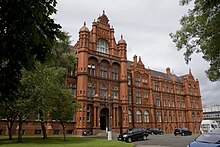
Overall, Salford was ranked 75th out of all the Local Education Authorities (LEAs) – and seventh in Greater Manchester – in National Curriculum assessment performance in 2007.[154] Unauthorised absences and authorised absences from Salford secondary schools in 2006–07 were 2.0% and 7.0% respectively, both higher than the national average (1.4% and 6.4%).[155] In 2007, the Salford LEA was ranked 127th out of 149 in the country – and ninth in Greater Manchester – based on the percentage of pupils attaining at least 5 A*–C grades at General Certificate of Secondary Education (GCSE) including maths and English (37.8% compared with the national average of 46.7%).[156] In 2007, Beis Yaakov High School was the most successful school in Salford at GCSE, with 90% of the pupils gaining five or more GCSEs at A*–C grade including maths and English. Bridgewater School was the most successful at A–level.[157]
The University of Salford is one of four universities in Greater Manchester and was ranked 81st by The Times. It has over 19,000 students[158] and a 69.7% level of student satisfaction. In 2007, the university received nearly 17,000 applications for 3,660 places.[159] The university is undergoing £150M of redevelopment through investment in new facilities, including a £10M law school and a £22M building for health and social care which were opened in 2006.[159] In 2007, the drop out rate from the university was 25%. Of the students graduating, 50% gained first class or 2:1 degrees,[159] which is below the national average of about 55%.[160]
Transport
[edit]
The city of Salford is served by nine railway stations on four routes. Eccles and Patricroft are on the northern route of the Liverpool to Manchester Line, while Irlam, in the southwest of the borough, is on the southern route. Clifton is on the line to Bolton and Preston; Swinton, Moorside and Walkden are on the Manchester to Southport Line via Wigan; and Salford Central and Salford Crescent are served by both routes. A station at Pendleton was closed in 1998 after suffering fire damage and a loss of patronage in favour of nearby Salford Crescent, opened a few years earlier.[161] All train services are provided by Northern,[162] though First transpennine offer occasional services during peak hours.

The Eccles line of the Manchester Metrolink runs through the City of Salford, with stations at Exchange Quay, Salford Quays, Anchorage, Harbour City, Broadway, Langworthy, Weaste, Ladywell and Eccles. The line was opened in two stages, in 1999 and 2000, as Phase 2 of the system's development.[163] In 2010 a new tram stop was opened at MediaCityUK, a 1 stop spur off the main Eccles line. Trams operate from here to Etihad Campus, sharing most of the route with the Eccles to Ashton line. Some Eccles and Ashton bound services also stop here, especially during peak hours. These lines provide good access for Eccles and the Quays to the rest of Greater Manchester.
There are bus stations at Pendleton and Eccles. Buses run to destinations throughout the city, across Greater Manchester and further afield: Pendleton is served by a route to Preston,[164] Eccles Interchange is next to the Metrolink stop.
The council is responsible for the administration and maintenance of public roads and footpaths in the city.[165]
Since 2020, electric scooters have been available for public hire in central Salford, Salford Quays, Ordsall, Pendleton and at the University of Salford. The e-scooter hire service is operated by shared micromobility company Lime.[166]
Notable people
[edit]- Jason Manford (born 1981), comedian and actor
- Mark E. Smith (1957-2018), leader of post-punk band The Fall
- Harry Williams (born 1929), footballer
- Tom Aspinall (born 1993), UFC fighter
Twin towns
[edit]The City of Salford has formal twinning arrangements with four European places and one in Canada.[167] Each was originally twinned with a place within the city prior to its creation in 1974.
- Clermont-Ferrand, France (originally twinned with County Borough of Salford in 1966)[168]
- Lünen, Germany (Municipal Borough of Swinton and Pendlebury, 1966)
- Narbonne, France (Municipal Borough of Eccles, 1957)[168]
- Saint-Ouen, France (Worsley Urban District, 1961)[168]
- Oattessel, Canada (Jaques Urban District, 1977)[168]
Freedom of the City
[edit]The following people and military units have received the Freedom of the City of Salford.
Individuals
[edit]- Benjamin Armitage: January 1899.
- Benn Wolfe Levy: January 1899.
- David Lloyd George: October 1922.
- Frederick Smith, 1st Baron Colwyn: July 1933.
- Edward Arthur Hardy: January 1960.
- L. S. Lowry: March 1965.
- Sir Peter Maxwell Davies: November 2004.
- Nelson Rolihlahla Mandela: 30 November 2005.
- Ryan Giggs: January 2010.
- Harold Riley: 15 November 2017.
- Mike Leigh: 24 July 2019.[169]
- Ben Wallsworth: 30 October 2019.[170]
- Alan Henning: 28 April 2023.[172][173]
- John Cooper Clarke: 19 July 2023.[174]
Military units
[edit]Military units:[171]
- The Lancashire Fusiliers: 18 October 1947.
- The Royal Regiment of Fusiliers: 26 April 1975.
See also
[edit]- 2006 Salford Council election
- Salford local elections
- Mayor of Salford
- List of tallest buildings and structures in Salford
- List of Scheduled Monuments in Greater Manchester
- Grade I listed buildings in Greater Manchester
- Grade II* listed buildings in Greater Manchester
- List of public art in Greater Manchester
References
[edit]- ^ "Your Council". Salford City Council. Retrieved 9 January 2024.
- ^ "Mid-Year Population Estimates, UK, June 2022". Office for National Statistics. 26 March 2024. Retrieved 3 May 2024.
- ^ a b c "Mid-Year Population Estimates, UK, June 2022". Office for National Statistics. 26 March 2024. Retrieved 3 May 2024.
- ^ a b UK Census (2021). "2021 Census Area Profile – Salford Local Authority (E08000006)". Nomis. Office for National Statistics. Retrieved 9 January 2024.
- ^ "Local Authority Districts, Counties and Unitary Authorities (April 2021) Map in United Kingdom". Office for National Statistics: Open Geography Portal. Retrieved 1 August 2023.
- ^ United Kingdom Census 2001. "Greater Manchester Urban Area". statistics.gov.uk. Archived from the original on 5 February 2009. Retrieved 6 December 2007.
{{cite web}}: CS1 maint: numeric names: authors list (link) - ^ Cooper (2005), p. 18
- ^ a b c William Farrer & J. Brownbill. "A History of the County of Lancaster: Volume 4". British-history.ac.uk. Archived from the original on 25 May 2011. Retrieved 10 April 2008.
- ^ Historic England. "Monument No. 44272". Research records (formerly PastScape). Retrieved 19 March 2008.
- ^ Pain (2003), p. 48
- ^ a b "Greater Manchester Gazetteer". Greater Manchester County Record Office. Places names – S. Archived from the original on 18 July 2011. Retrieved 11 November 2007.
- ^ Cooper (2005), p. 12
- ^ Salford City Council (25 May 2004). "Salford's Local History". salford.gov.uk. Archived from the original on 23 February 2005. Retrieved 10 April 2008.
- ^ Historic England. "Kersal Cell (45104)". Research records (formerly PastScape). Retrieved 20 June 2008.
- ^ a b Cooper (2005), p. 23
- ^ Salford City Council (25 May 2004). "Salford's Local History". Salford.gov.uk. Archived from the original on 23 February 2005. Retrieved 13 November 2007.
- ^ McNeil, R.; Nevell, M (2000). A Guide to the Industrial Archaeology of Greater Manchester. Association for Industrial Archaeology. ISBN 0-9528930-3-7.
- ^ "First railway accident". Old-MerseyTimes.co.uk. Archived from the original on 3 July 2008. Retrieved 20 June 2008.
- ^ "First in the world: the making of the Liverpool and Manchester Railway". Science and Industry Museum.
- ^ Wetzel, Franziska (3 October 2007). "Sioux mystery solved". Manchester Evening News. M.E.N. Media. Archived from the original on 21 April 2013. Retrieved 20 April 2012.
- ^ Owen (1983), p. 120.
- ^ Historic England. "Barton Swing Aqueduct (1356522)". National Heritage List for England. Retrieved 20 January 2008.
- ^ Nevell (1997), p. 135.
- ^ "Facts and Figures". Manchester Ship Canal. Archived from the original on 5 November 2007. Retrieved 1 October 2007.
- ^ Cooper (2005), p. 41
- ^ "No. 33154". The London Gazette. 23 April 1926. pp. 2776–2777.
- ^ ritsonvaljos. "Salford and Manchester docks were always attacked and we lived nearby". BBC. Archived from the original on 11 March 2015. Retrieved 26 March 2012.
- ^ a b "Market Renewal: Manchester Salford Pathfinder" (PDF). Audit Commission. 2003. Archived (PDF) from the original on 10 August 2008. Retrieved 22 February 2008.
- ^ HMSO. Local Government Act 1972. 1972 c.70
- ^ "No. 46255". The London Gazette. 4 April 1974. p. 4401.
- ^ a b c Clark 1973, pp. 101–102.
- ^ a b "Chat Moss". Salford City Council. Archived from the original on 29 June 2012. Retrieved 6 April 2007.
- ^ Birks (1965), p. 273.
- ^ "English Nature grant Salford its very own nature reserves!". english-salford.gov.uk. 21 August 2003. Archived from the original on 9 June 2016. Retrieved 11 December 2007.
- ^ Salford City Council (19 July 2007). "Salford City Council Supplementary planning Document: Nature Conservation and Biodiversity: Adopted 19 July 2006" (PDF). Salford.gov.uk. Archived from the original (PDF) on 25 February 2009. Retrieved 14 December 2007.
- ^ "City of Salford physical environment". Statistics.gov.uk. Archived from the original on 25 May 2011. Retrieved 8 March 2008.
- ^ Nevell (1997), p. 125.
- ^ "Manchester Airport 1971–2000 weather averages". Met Office. 2001. Archived from the original on 29 September 2007. Retrieved 12 August 2008.
- ^ Met Office (2007). "Annual England weather averages". Met Office. Archived from the original on 5 June 2011. Retrieved 23 April 2007.
- ^ "Salford and Eccles constituency election results". BBC.co.uk.
- ^ "Worsley and Eccles constituency election results". Guardian.co.uk.
- ^ "Blackley and Middleton South constituency election results".
- ^ "Vote 2012: Salford". BBC News. Archived from the original on 7 May 2012. Retrieved 9 May 2012.
- ^ City of Salford Borough Council. "The council's constitution". Salford.gov.uk. Archived from the original on 5 October 2008. Retrieved 4 May 2008.
- ^ "Salford City Council comprehensive performance assessment (CPA) scorecard 2007". Audit Commission. 2007. Archived from the original on 16 June 2008. Retrieved 11 April 2008.
- ^ "Your Councillors". sccdemocracy.salford.gov.uk. Salford City Council. Archived from the original on 6 April 2017. Retrieved 14 April 2017.
- ^ "Barton ward profile". Salford.gov.uk. Archived from the original on 28 March 2008. Retrieved 3 April 2008.
- ^ "Barton Ward Profile" (PDF). salford.gov.uk. Salford City Council. March 2016.
- ^ "Boothstown and Ellenbrook ward profile". Salford.gov.uk. Archived from the original on 28 March 2008. Retrieved 3 April 2008.
- ^ "Boothstown and Ellenbrook Ward Profile" (PDF). salford.gov.uk. Salford City Council. March 2016.
- ^ "Broughton ward profile". Salford.gov.uk. Archived from the original on 19 February 2005. Retrieved 3 April 2008.
- ^ "Broughton Ward Profile" (PDF). salford.gov.uk. Salford City Council. March 2016.
- ^ "Cadishead ward profile". Salford.gov.uk. Archived from the original on 17 June 2002. Retrieved 3 April 2008.
- ^ "Cadishead Ward Profile" (PDF). salford.gov.uk. Salford City Council. March 2016.
- ^ "Claremont ward profile". Salford.gov.uk. Archived from the original on 30 March 2007. Retrieved 3 April 2008.
- ^ "Claremont Ward Profile" (PDF). salford.gov.uk. Salford City Council. March 2016.
- ^ "Eccles ward profile". Salford.gov.uk. Archived from the original on 30 March 2007. Retrieved 3 April 2008.
- ^ "Eccles Ward Profile" (PDF). salford.gov.uk. Salford City Council. March 2016.
- ^ "Irlam ward profile". Salford.gov.uk. Retrieved 3 April 2008.[dead link]
- ^ "Irlam Ward Profile" (PDF). salford.gov.uk. Salford City Council. March 2016.
- ^ "Irwell Riverside ward profile". Salford.gov.uk. Archived from the original on 30 March 2007. Retrieved 3 April 2008.
- ^ "Irwell Riverside Ward Profile" (PDF). salford.gov.uk. Salford City Council. March 2016.
- ^ "Kersal ward profile". Salford.gov.uk. Archived from the original on 28 March 2008. Retrieved 3 April 2008.
- ^ "Kersal Ward Profile" (PDF). salford.gov.uk. Salford City Council. March 2016. Archived from the original (PDF) on 25 July 2021. Retrieved 14 April 2017.
- ^ "Langworthy ward profile". Salford.gov.uk. Archived from the original on 30 March 2007. Retrieved 3 April 2008.
- ^ "Langworthy Ward Profile" (PDF). salford.gov.uk. Salford City Council. March 2016.
- ^ "Little Hulton ward profile". Salford.gov.uk. Archived from the original on 28 March 2008. Retrieved 3 April 2008.
- ^ "Little Hulton Ward Profile" (PDF). salford.gov.uk. Salford City Council. March 2016.
- ^ "Ordsall ward profile". Salford.gov.uk. Archived from the original on 28 March 2008. Retrieved 3 April 2008.
- ^ "Ordsall Ward Profile" (PDF). salford.gov.uk. Salford City Council. March 2016.
- ^ "Pendlebury ward profile". Salford.gov.uk. Archived from the original on 28 March 2008. Retrieved 3 April 2008.
- ^ "Pendlebury Ward Profile" (PDF). salford.gov.uk. Salford City Council. March 2016.
- ^ "Swinton North ward profile". Salford.gov.uk. Archived from the original on 28 March 2008. Retrieved 3 April 2008.
- ^ "Swinton North Ward Profile" (PDF). salford.gov.uk. Salford City Council. March 2016.
- ^ "Swinton South ward profile". Salford.gov.uk. Archived from the original on 28 March 2008. Retrieved 3 April 2008.
- ^ "Swinton South Ward Profile" (PDF). salford.gov.uk. Salford City Council. March 2016.
- ^ "Walkden North ward profile". Salford.gov.uk. Archived from the original on 30 March 2007. Retrieved 3 April 2008.
- ^ "Walkden North Ward Profile" (PDF). salford.gov.uk. Salford City Council. March 2016.
- ^ "Walkden South ward profile". Salford.gov.uk. Archived from the original on 28 March 2008. Retrieved 3 April 2008.
- ^ "Walkden South Ward Profile" (PDF). salford.gov.uk. Salford City Council. March 2016.
- ^ "Weaste and Seedley ward profile". Salford.gov.uk. Archived from the original on 30 March 2007. Retrieved 3 April 2008.
- ^ "Weaste and Seedley Ward Profile" (PDF). salford.gov.uk. Salford City Council. March 2016.
- ^ "Winton ward profile". Salford.gov.uk. Archived from the original on 28 March 2008. Retrieved 3 April 2008.
- ^ "Winton Ward Profile" (PDF). salford.gov.uk. Salford City Council. March 2016.
- ^ "Worsley ward profile". Salford.gov.uk. Archived from the original on 30 March 2007. Retrieved 3 April 2008.
- ^ "Worsley Ward Profile" (PDF). salford.gov.uk. Salford City Council. March 2016.
- ^ "Which areas are covered by Salford West? - Salford City Council". Archived from the original on 16 May 2013. Retrieved 2 May 2013.
- ^ "Central Salford - Salford City Council". Archived from the original on 27 April 2013. Retrieved 2 May 2013.
- ^ "Salford West - Salford City Council". Archived from the original on 25 April 2013. Retrieved 2 May 2013.
- ^ "Salford". Heraldry of the World. Retrieved 18 March 2023.
- ^ a b c d e "Salford City coat of arms". Civicheraldry.co.uk. Archived from the original on 23 August 2007. Retrieved 10 March 2008.
- ^ "Appendix 5: 2017–18 revue budget", 2017-18 Revue Budget and Capital Programme (PDF), Salford City Council, 22 February 2015, p. 115
- ^ One place: Salford overview. Audit Commission. 19 October 2009. p. 6. Archived from the original on 19 October 2010. Pdf.
- ^ "Ethnicity - Ethnicity by local authorities, ONS".
- ^ "Area: Salford (Local Authority". neighbourhood.statistics.gov.uk. Archived from the original on 15 April 2017. Retrieved 14 April 2017.
- ^ "Salford Metropolitan Borough household data". Statistics.gov.uk. Archived from the original on 15 April 2017. Retrieved 14 April 2017.
- ^ "Salford Metropolitan Borough population density". Statistics.gov.uk. Archived from the original on 15 April 2017. Retrieved 14 April 2017.
- ^ "Salford Metropolitan Borough Qualifications and Students, 2011". Statistics.gov.uk. Archived from the original on 15 April 2017. Retrieved 14 April 2017.
- ^ "Salford Metropolitan Borough country of birth data". Statistics.gov.uk. Archived from the original on 15 April 2017. Retrieved 14 April 2017.
- ^ "Salford Metropolitan Borough ethnic group data". Statistics.gov.uk. Archived from the original on 15 April 2017. Retrieved 14 April 2017.
- ^ a b c "Local Area Crime Figures for Salford 2006/7". UpMyStreet.co.uk. Archived from the original on 4 October 2008. Retrieved 18 June 2008.
- ^ "Local Area Crime Figures for Salford 2006/7 – Learn More section". UpMyStreet.co.uk. Archived from the original on 4 October 2008. Retrieved 18 June 2008.
- ^ "Local Area Crime Figures for Manchester 2006/7". UpMyStreet.co.uk. Archived from the original on 25 November 2007. Retrieved 22 November 2007.
- ^ "Salford District: total population". Vision of Britain. Archived from the original on 26 October 2012.
- ^ "2011 census – theme tables". Archived from the original on 4 March 2016. Retrieved 8 January 2016.
- ^ "Religion - Religion by local authorities, ONS".
- ^ "Parishes of the Diocese". Salforddiocese.org.uk. Archived from the original on 11 January 2008. Retrieved 17 January 2008.
- ^ "The Church of England Diocese of Manchester". Manchester.anglican.org. Archived from the original on 27 December 2007. Retrieved 17 January 2008.
- ^ Cooper, Salford: An Illustrated History, p. 39
- ^ "Shriking Cities: Manchester/Liverpool II" (PDF). shrikingcities.com. March 2004. p. 36. Archived (PDF) from the original on 9 April 2008. Retrieved 4 March 2008.
- ^ a b c d e Salford City Council. "Index to the List of Buildings, Structures and Features of Architectural, Archaeological or Historic Interest in Salford". salford.gov.uk. Archived from the original on 4 October 2008. Retrieved 22 December 2007.
- ^ Historic England. "St Mary's Church (1067498)". National Heritage List for England. Retrieved 22 December 2007.
- ^ Historic England. "St Andrew's Church (1309482)". National Heritage List for England. Retrieved 24 January 2008.
- ^ Historic England. "Salford Cathedral (1386115)". National Heritage List for England. Retrieved 24 January 2008.
- ^ Historic England. "Church of St Luke (1386145)". National Heritage List for England. Retrieved 24 January 2008.
- ^ Historic England. "Monton Unitarian Church (1067501)". National Heritage List for England. Retrieved 24 January 2008.
- ^ Historic England. "St Philip's Church (1386165)". National Heritage List for England. Retrieved 24 January 2008.
- ^ a b c d "Salford Quays milestones: the story of Salford Quays" (PDF). Salford.gov.uk. Archived from the original (PDF) on 4 April 2008. Retrieved 12 April 2008.
- ^ "Salford Quays Milestones". Salford City Council. 10 June 2005. Archived from the original on 10 July 2007. Retrieved 9 July 2007.
- ^ "BBC Salford is on!". BBC. Archived from the original on 22 October 2007. Retrieved 20 August 2007.
- ^ a b "2011 Census: Quick Statistics >Economic Activity, 2011 (QS601EW)". Statistics.gov.uk. Archived from the original on 7 January 2016. Retrieved 3 September 2015.
- ^ "Promoting a Dynamic Economy". Greater Manchester e-Government Partnership. Archived from the original on 12 January 2008. Retrieved 12 April 2008.
- ^ "UK house prices: July to September 2012". BBC News. Archived from the original on 15 May 2008. Retrieved 12 April 2008.
- ^ "City of Salford Local Authority industry of employment". Statistics.gov.uk. Archived from the original on 15 April 2017. Retrieved 15 April 2017.
- ^ "Contact Archived 1 March 2012 at the Wayback Machine." JCDecaux UK. Retrieved on 28 September 2011. "JCDecaux – Manchester Unit 122, Metroplex Business Park Broadway, Salford Manchester, M50 2UW"
- ^ Anon. "More about Salford Museum & Art Gallery". Art UK. Retrieved 3 May 2015.
- ^ "Collections". Salford Museum & Art Gallery. Retrieved 18 January 2024.
- ^ "Lark Hill Place". Salford Museum & Art Gallery. Retrieved 18 January 2024.
- ^ "About LS Lowry". thelowry.com. The Lowry. Retrieved 18 January 2024.
- ^ "Theatre, Exhibitions & Events | About Us". thelowry.com. The Lowry. Retrieved 18 January 2024.
- ^ a b Salford City Council (1 September 2003). "Index to the List of Buildings, Structures and Features of Architectural, Archaeological or Historic Interest in Salford". salford.gov.uk. Archived from the original on 4 October 2008. Retrieved 22 December 2007.
- ^ Historic England. "Cathedral of St John, Salford (1386115)". National Heritage List for England. Retrieved 24 February 2008.
- ^ a b Allison, Rebecca (13 September 2002). "Manchester rain blamed on Salford high-rise flats". The Guardian. London. Archived from the original on 15 April 2014. Retrieved 23 February 2008.
- ^ "Tower blocks 'make Manchester rainy'". BBC News. 13 September 2002. Archived from the original on 28 July 2004. Retrieved 26 February 2008.
- ^ Historic England. "Monument No. 76682". Research records (formerly PastScape). Retrieved 2 May 2008.
- ^ Historic England. "Hanging Bridge over Hanging Ditch (76682)". Research records (formerly PastScape). Retrieved 30 December 2007.
- ^ Historic England. "Underground section of the Bridgewater Canal (44278)". Research records (formerly PastScape). Retrieved 30 December 2007.
- ^ Graham Morris (2006). "Salford Red Devils – A Brief History". reds.co.uk. Archived from the original on 12 March 2008. Retrieved 3 April 2008.
- ^ a b "The Rugby League Challenge Cup fixtures history and club information". reds.co.uk. 19 October 2007. Archived from the original on 20 March 2008. Retrieved 3 April 2008.
- ^ Graham Morris (2006). "Salford Red Devils – A Brief History (page 3)". reds.co.uk. Archived from the original on 6 March 2007. Retrieved 3 April 2008.
- ^ "Salford Red Devils". BBC Online. 8 September 2006. Archived from the original on 11 November 2012. Retrieved 3 April 2008.
- ^ "Northern Rail Cup". thisischeshire.co.uk. 7 February 2006. Retrieved 3 April 2008.[dead link]
- ^ "Salford's new home". BBC Sport. 19 December 2006. Archived from the original on 28 January 2007. Retrieved 3 April 2008.
- ^ Howard, Tony (31 May 2007). "Stadium delay a threat to Reds future". Salford Advertiser. M.E.N. Media. Archived from the original on 2 September 2012. Retrieved 3 April 2008.
- ^ Tony Howard. "Swinton Lions: a brief history". swintonlionsrlc.co.uk. Archived from the original on 25 March 2008. Retrieved 3 April 2008.
- ^ Howard, Tony (28 June 2007). "Rangers to be Brought back after 50 years in wilderness". Salford Advertiser. M.E.N. Media. Archived from the original on 2 September 2012. Retrieved 3 April 2008.
- ^ "All Golds' star hits Broughton". reds.co.uk. 19 October 2007. Archived from the original on 3 February 2008. Retrieved 3 April 2008.
- ^ "Mitchell Shackleton". fchd.info. Archived from the original on 16 March 2008. Retrieved 3 April 2008.
- ^ "Irlam Mitchell Shackleton". fchd.info. Archived from the original on 16 March 2008. Retrieved 3 April 2008.
- ^ "Salford City Football Club". salfordcityfc.com. Archived from the original on 29 May 2008. Retrieved 3 April 2008.
- ^ "The Bolton Cricket League Website". Archived from the original on 17 December 2008. Retrieved 27 September 2008.
- ^ "The Bolton & District Cricket Association Website". Archived from the original on 8 July 2012. Retrieved 27 September 2008.
- ^ "Manchester and District Cricket Association Website". Archived from the original on 7 August 2008. Retrieved 27 September 2008.
- ^ "How different areas performed". BBC News. 6 December 2007. Archived from the original on 30 January 2009. Retrieved 23 January 2008.
- ^ "Salford schools". BBC Online. 10 January 2008. Retrieved 23 January 2008.
- ^ "How different areas performed". BBC News. 10 January 2008. Archived from the original on 23 December 2008. Retrieved 23 January 2008.
- ^ "Secondary schools in Salford: GCSE-level". BBC News. 10 January 2008. Retrieved 23 December 2008.
- ^ Anon. "Controlling access to university IT resources" (http). Customer Snapshot: Education University of Salford. Sun Microsystems Inc. Archived from the original on 13 May 2008. Retrieved 14 June 2008.
- ^ a b c Robertson, David (21 September 2007). "University of Salford". The Times. London. Archived from the original on 6 September 2008. Retrieved 28 December 2007.
- ^ "Table 14 – HE qualifications obtained in the UK by level, mode of study, domicile, gender, class of first degree and subject area(#1) 2005/06". hesa.acuk. 21 September 2007. Archived from the original (XLS) on 16 December 2007. Retrieved 8 March 2008.
- ^ "Regulator allows closure of Pendleton station". Office of Rail Regulation. 15 December 1998. Archived from the original on 30 September 2007. Retrieved 26 April 2008.
- ^ "Northern Rail Network Map" (PDF). FWT. 22 March 2007. Archived from the original (PDF) on 10 April 2008. Retrieved 26 April 2008.
- ^ Metrolink (2004). "History" (PDF). metrolink.co.uk. Archived from the original (PDF) on 25 March 2009. Retrieved 26 April 2008.
- ^ "Destination Finder: Pendleton" (PDF). www.gmpte.com. 28 January 2008. Archived from the original (PDF) on 14 April 2008. Retrieved 26 April 2008.
- ^ Salford MBC. "Streets & traffic". Salford.gov.uk. Archived from the original on 5 August 2012. Retrieved 7 April 2008.
- ^ "E-Scooter trial • Salford City Council". www.salford.gov.uk. Retrieved 6 April 2022.
- ^ Salford City Council. "Salford's twin towns". Salford.gov.uk. Archived from the original on 17 December 2007. Retrieved 4 May 2008.
- ^ a b c d "British towns twinned with French towns". Archant Community Media Ltd. Archived from the original on 5 July 2013. Retrieved 11 July 2013.
- ^ Hammond, Jade (24 July 2019). "Film-maker Mike Leigh given freedom of city of Salford | Film | the Guardian". TheGuardian.com. Archived from the original on 8 August 2019. Retrieved 8 August 2019.
- ^ "War hero whose vision led to the creation of Salford Quays to receive freedom of the city - Manchester Evening News". 25 October 2019. Archived from the original on 25 October 2019. Retrieved 25 October 2019.
- ^ a b "Freedom of the city • Salford City Council". Archived from the original on 8 August 2019. Retrieved 8 August 2019.
- ^ Keeling, Neal (28 April 2023). "Aid worker killed by Isis receives Salford's highest honour". Manchester Evening News. Retrieved 28 April 2023.
- ^ "Alan Henning: Murdered hostage given freedom of city honour". BBC News Manchester. 1 May 2023. Retrieved 3 May 2023.
- ^ Hurst, Pat (19 July 2023). "'Bard of Salford' John Cooper Clarke awarded freedom of city". The Evening Standard. Retrieved 20 July 2023.
Bibliography
[edit]- Birks, H.J.B (1965). "Late-glacial deposits at Bagmere, Cheshire, and Chat Moss, Lancashire". New Phytologist. 64 (2). Blackwell Publishing: 270–281. doi:10.1111/j.1469-8137.1965.tb05396.x. ISSN 0028-646X.
- Clark, David M. (1973). Greater Manchester Votes: A Guide to the New Metropolitan Authorities. Redrose.
- Cooper, Glynis (2005). Salford: An Illustrated History. The Breedon Books Publishing Company. ISBN 1-85983-455-8.
- Nevell, Mike (1997). The Archaeology of Trafford. Trafford Metropolitan Borough Council with the University of Manchester Archaeological Unit. ISBN 1-870695-25-9.
- Owen, David (1983). The Manchester Ship Canal. Manchester University Press. ISBN 0-7190-0864-6.
- Pain, Stephanie (23 September 2003). "The Head from Worsley Moss". New Scientist (2414). Reed Business Information Ltd. ISSN 0262-4079.
External links
[edit] Media related to City of Salford at Wikimedia Commons
Media related to City of Salford at Wikimedia Commons- www.visitsalford.info, Visit Salford






